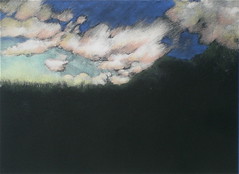
Website: web.me.com/jfdyment/Lori
Etsy: DeanDymentStudios.etsy.com
Flickr: flickr.com/photos/ldeandyment
Artfire: http://DeanDymentstudios.artfire.com
Blog: ldeandyment-soiwasthinking.blogspot.com
How did you get started in printmaking?
I attended Emily Carr Institute of Art and Design and saw a fourth year student demo silkscreening when I was in first year. I had planned to do graphic design when I entered (the profession that was the safest to pay the bills) and I ended up doing a painting and printmaking major. I was frustrated with the painting instruction I was getting and decided to make use of the printmaking equipment while I had it. A fellow printmaking student was doing reductive monotypes and showed me some techniques. I was hooked right away as it was a wonderful halfway medium between oil painting and the technically intense intaglio. I have been doing monotypes on the same steel plate for over sixteen years now.
Describe where you work:
The extra bedroom in our apartment is the studio that I share with my husband who is a painter. I have a custom press that I keep on a sturdy desk. My mother in-law gave me the press as a wedding present and it has worked really well. Like most artists, I feel like it’s too small and cramped. My work table is stuffed in the closet and is way too low for me to work standing up which is what I need to do when working on a monotype. My studio wish list also includes proper lighting because I end up in the studio once the kids are asleep. However, I’m really glad that I can work in my pajamas if I want to and that I don’t have to commute to some industrial area while paying a fortune in studio rent. You take what you can.
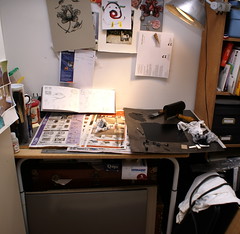
What is your favorite printmaking process?
I have to say that reductive monotypes are my favorite although I also really enjoy linocuts, drypoints and collographs. I feel monotypes are closer to painting and so very immediate and spontaneous. I love all the happy accidents that happen when I start pulling away the ink. The beautiful and velvety blacks are a big draw too. I’m finding that I’m trying hard to leave larger areas of untouched ink just so I can see a fully printed black. I use Charbonelle intaglio ink and it’s just beautiful.
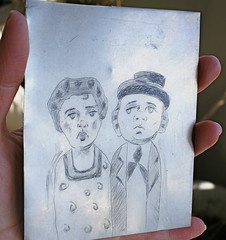
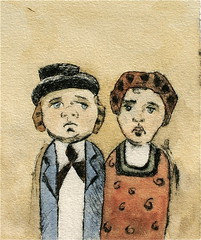 What’s your creative process for any given print?
What’s your creative process for any given print?All my work is based on drawings in my sketchbook. I go through spurts of drawing and then I go through my images and decide if any are worth working on in a print format. If the drawing is not detailed enough then it won’t make a very good print. I used to rely heavily on reference material for inspiration but as of late, I’m creating images that just come to me and are more intuitive. I’m really enjoying the variety of work I’m doing.
What do you enjoy most about printmaking?
This is a tough one. I really like creating the image on the plate and coming up with a little story to go with it while I’m doing it. But I also really enjoy seeing what the monotype looks like once it has been printed. The paper is white and my plate is grey, so along with the oil content of the ink, the pressure of the press, and the dampness of the paper there are quite a few variables to make the final print a surprise.
What’s your least favorite part of the process?
Besides cleaning up I have to say that I don’t really enjoy inking up and wiping plates or hand rubbing linocuts.( I’m trying to figure out how to do that on my press)
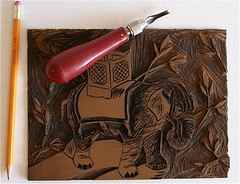
What are your inspirations?
I’m inspired by so many different things but I seem to gravitate to animal and nature imagery and anything to do with children. I just love looking at children’s books and I would love to make a career of illustrating for children someday. I still remember some of the books I read when I was younger based on the images only. I’m finding plenty of inspiration from other artists work now that I’m more present online. Nothing makes me want to create than seeing wonderful artwork.
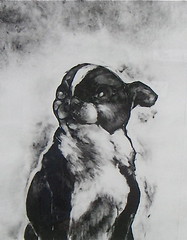
How has your work changed and evolved since you started?
I had a harder time coming up with imagery when I was in art school and was afraid of what people thought of my work and if it was “commercial” looking or not. Over time I have found that my list of goals, images and ideas surrounding my artwork has grown exponentially. Now that I have very little time to create I have so many ideas to work on. Now I’m starting to work on the same image but in different mediums to see how things turn out. I’m also trying to work on things as a series which is something I would never do before. It always seemed boring or obsessive compulsive to me.
How do you get past creative slumps?
Whenever I haven’t been in the studio for awhile I get really nervous and start finding other things to do, like the laundry. I find that if I just start drawing in my sketchbook without any expectations that I will loosen up and things will just start flowing. The flip-side is that once I start working regularly in the studio, other things like my job seem frivolous and a waste of valuable time. I end up craving to be in the studio even more.
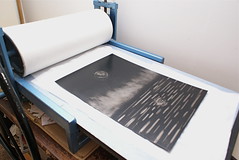
How do you promote your work?
At the moment I’m trying to get more of an online presence because that seems to bring me the most viewers for the lowest cost. I recently had a gallery show and it cost me a mini-fortune in mats, frames, time off, etc. I’m showing my work on Etsy, Artfire, Indiepublic, RedBubble, Imagekind, HandmadeByMe, Fickr, my blog and a couple other artist community sites. It’s been great for connecting with other artists and so many people are willing to provide help or advice if you need it.
I hope to get involved in a local Etsy sale if it fits with my work. I’m still coming up with plans to provide my work in a way that’s affordable to my target market. Stay tuned for art pendants, digital prints, cards, magnets, and buttons.

Any other comments or advice for others who want to try making hand-pulled prints?
Experiment with low tech methods such as linocuts that are hand rubbed before investing in too many tools. I have a lovely mezzotint rocker that is just collecting dust. My other suggestion is to take a printmaking course at the local art school where you’d get a feel for the tools, equipment and techniques.
1 comment:
beautiful prints! i love the velvety deep textures you pull out in your work!
Post a Comment